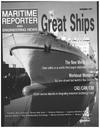
Page 35: of Maritime Reporter Magazine (December 1997)
Read this page in Pdf, Flash or Html5 edition of December 1997 Maritime Reporter Magazine
0Continued from page 33) patterns. Topological modeling is used extensively for hull structure definitions to facilitate design alterations and new product development based on derivatives from previous designs.
Third Party Development
Howaldtswerke-Deutsche Werft (HDW) has taken a different approach from Hitachi, Odense and
MHI, and outsources many of its support functions, including the development of CAD systems. Two of its support organizations in the ship design area are
Norddeutsche Informations-Systeme GmbH (NIS) and SMK Ingenieurburo GmbH. A key principle guiding the HDW efforts to enhance profitability was to re-engineer business processes first, before attempting to automate these processes. The 80/20 rule of carrying out 80 percent implementation at 20 percent of the cost was adhered to in developing process improvement plans. These plans and their underlying concepts were evaluated annually and adjusted by experience to-date. Hardware (NC and robotics) vendors and software vendors were involved in the planning.
FACTORY AUTOMATION
Over the past 10 years, leading European and
Japanese shipyards have invested a significant amount of effort in the development and implemen- tation of robotics and other factory automation tech- nology in their manufacturing processes. Factory automation is viewed by these yards as increasing- ly important in maintaining their competitive edge into the 21st century.
Reducing Construction Span Times
World-class shipyards in Europe and Japan con- tinuously strive to reduce the time to design and construct their ships. One way to help reduce these span times is through the use of robotics. This tech- nology enables shipyards to weld at the cell level rather than at numerous intermediate steps, thus reducing the number of production stations. This directly reduces the level of work decomposition, block moves, material handling, welding distortion and manual straightening operations. All this results in fewer operations (planned and unplanned) and therefore shorter total construction span times.
Maintaining critical labor skills in areas such as welding, painting and forming is crucial to all ship- yards. In shipyards around the world, operations managers are having to deal with shrinking quali- fied labor forces in the metal trades and with cyclic levels of work. Often, they find it impractical to maintain a fixed level of shop employees or to train new personnel only to meet production peaks. As a result, many world-class yards are turning to com- puter-based technology and machines to perform critical tasks. Shipyards using this approach report increases in response time and quality control in fabrication and assembly. A key benefit of factory automation, particularly in the area of robotics, is the increase of production predictability and the corresponding reduction in span time variability in shipbuilding assembly processes.
The high degree of repeatability of machine oper-
December, 1997 ^SBp1' • Grade 2
Grade 3
R3-R3S
R4 • Large stock of chains, from 16 to 178 mm. • Stud and
Studless
TTTpjlkT Particular de Sagarduy, 5
V 3\s X 111 XX X Phone 34+4+489 11 30 • Telex 32741 C ADEN AS® S. A. Fax 34+4+489 11 40
BILBAO (Spain)
Circle 282 on Reader Service Card
Ship Design
Naval Architecture, Marine Engineering, and Program Support Services
Since 1957 - Commercial and Military Ship New Construction and Conversion Design, Detail Design, International
Construction Program Support, Marine Consulting, Pollution
Prevention Programs
New York, NY • Arlington, VA • Newport News, VA • Pittsburgh, PA
Port Hueneme, CA • Bath, ME • Seattle, WA • Pascagoula, MS illtiiiilli
John J. McMullen Associates, Inc.
Two World Trade Center,Suite 1510
New York, NY 10048
Tel: (212)466-2200 Fax: (212)466-2282
Circle 293 on Reader Service Card 37

 34
34

 36
36
